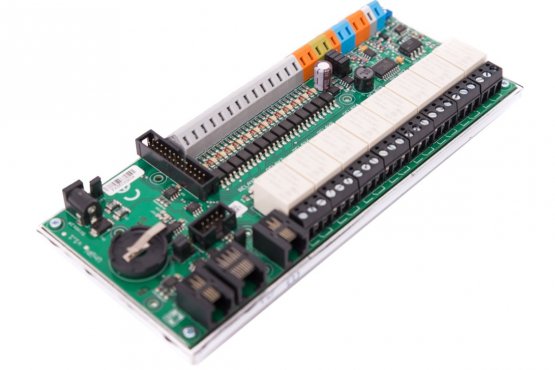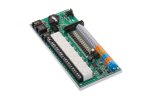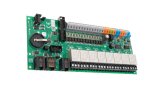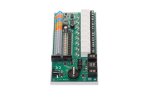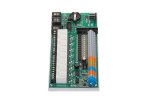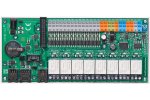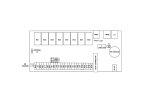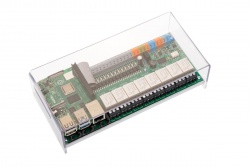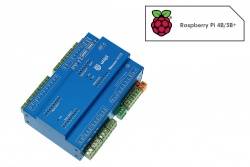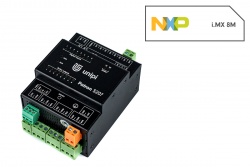Unipi 1.1
Unipi 1.1 is an extension board for the Raspberry Pi computer which allows it to function as a programmable logic controller for monitoring, control and regulation of automation systems. The board features a universal I/O architecture with digital inputs, a set of relays, analogue I/Os and broad connectivity thanks to 1-Wire bus, I2C and UART ports.
137,19 € excl. VAT
In stock > 50 pcs
Extra > 20 pcs within 10 days after ordering
Check availability
Product description
Unipi 1.1 is an extension board for the Raspberry Pi computer which allows it to function as a programmable logic controller for monitoring, control and regulation of automation systems. The board features a universal I/O architecture with digital inputs, a set of relays, analogue I/Os and broad connectivity thanks to 1-Wire bus, I2C and UART ports.
Note: The package does not contain the Raspberry Pi computer, a DIN rail holder, Mervis software license or protective cover. These components can be purchased separately or as part of the Unipi 1.1 complete set.
Package contents
- Unipi 1.1 board
- quick start guide
- 26 pin (2×13) flat cable to connect Unipi 1.1 to Raspberry Pi
- 3× metal spacer 2M5 (20mm)
- 3× screw 2M5
Basic Unipi 1.1 features
- 8× changeover relay (250 V AC/10A; 30 V DC/10 A)
- 12 + 2× galvanically isolated digital input (5-24 V DC, min. pulse length 5 ms)
- 2× analog input (0 - 10 V)
- 1× analog output (0 - 10 V)
- 1× 1-Wire bus
- 1× I2C port
- 1× UART port
- RTC module (battery not included)
Inputs & outputs
Digital inputs (DI) are designed to read binary logic states represented by direct voltage levels. That makes them suitable for reading data from various binary sensors and devices such as switches (on/off), motion sensors (movement detected/not detected), liquid level sensors (full tank/empty tank) etc.
Note: By default the digital inputs 13 and 14 are inaccessible. For their use please visit this tutorial.
Relay outputs (RO) are primarily used for switching two-state devices with higher current draw such as lightbulbs, thermoelectric valve drives, water heaters, pumps etc.
Analog inputs (AI) serve for measuring 0-10V DC voltage from various analog sensors such as thermometers, pressure meters, tensometers etc.
Analog output (AO) is designed for control of various external devices by direct voltage and is suitable for incremental control of devices such as three-way valves, heat exchangers, electric motors, lighting dimmers etc.
Computing module
Unipi 1.1 is powered by the Raspberry Pi computer. The board is compatible with the following Raspberry Pi models:
- Raspberry Pi Model B+
- Raspberry Pi 2 Model B
- Raspberry Pi 3 Model B
- Raspberry Pi 3 Model B+
- Raspberry Pi 4 Model B (all RAM variants)
Note: Unipi 1.1 cannot function without Raspberry Pi
Communication interfaces
Unipi 1.1 features UART port and I2C bus. The UART port can be used for serial communication with various external devices, while the I2C serves mainly for connection of the EMO-R8 relay extension module
The product also features a single 1-Wire bus for reading data from various 1-Wire sensors (thermometers, humidity meters, light intensity meters etc.). The bus usually utilizes 2-3 conductors and its maximum length is up to 200 meters. A single bus supports up to 15 connected sensors.
Software options
Due to the software openness of Unipi controllers the customer has a wide array of software solutions to choose from and is not limited to a single software.
The main supported platform for programming of Unipi controllers is the Mervis system. Mervis is developed according to the IEC 61131-3 standard for PLC programming and consists of SCADA interface for remote control and monitoring, comprehensible development interface, integrated HMI editor and online/on-premise database for storing data and historical analysis of the controlled technology's operation.
Aside from Mervis, Unipi controllers are also compatible with a wide variety of both commercial and open-source platforms. It is also possible to choose from a large number of open-source platforms, use EVOK API or implement your code in any programming language. For an overview of more compatible commercial solutions please visit Other software overview.
Package contents
- UniPi 1.1 board
- quick start guide
- 26 pin (2×13) flat cable to connect Unipi 1.1 to Raspberry Pi
- 3× metal spacer 2M5 (20mm)
- 3× screw 2M5
Further info
Documentation
|
Manual User guide and technical documentation |
download | |
|
Instruction leaflet Technical and safety information |
download |
| Digital inputs | 14 |
| Relay outputs | 8 |
| Analog inputs | 2 |
| Analog outputs | 1 |
| Power | 5 V DC / 2.4 A |
| 1-Wire bus | Ano |
| Dimensions | 20 mm × 86 mm ×198 mm |
| Weigth | 210 g |
| RTC battery socket | Ano |
